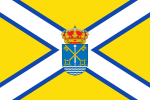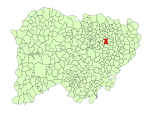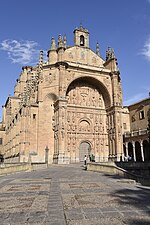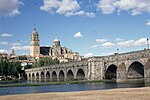Battle of Salamanca

The Battle of Salamanca (in French and Spanish known as the Battle of the Arapiles) on 22 July 1812 was a battle in which an Anglo-Portuguese army under the Earl of Wellington defeated Marshal Auguste Marmont's French forces at Arapiles, south of Salamanca, Spain, during the Peninsular War. A Spanish division was also present but took no part in the battle. The battle involved a succession of flanking manoeuvres in oblique order, initiated by the British heavy cavalry brigade and Pakenham's 3rd Division and continued by the cavalry and the 4th, 5th and 6th divisions. These attacks resulted in a rout of the French left wing. Marmont and his deputy commander, General Bonet, received shrapnel wounds in the first few minutes of firing. Confusion amongst the French command may have been decisive in creating an opportunity, which Wellington seized. General Bertrand Clauzel, third in seniority, assumed command and ordered a counter-attack by the French reserve toward the depleted Allied centre. The move proved partly successful but with Wellington having sent his reinforcements to the centre, the Anglo-Portuguese forces prevailed. Allied losses numbered 3,129 British and 2,038 Portuguese dead or wounded. The Spanish troops took no part in the battle as they were positioned to block French escape routes and suffered just six casualties. The French suffered about 13,000 dead, wounded and captured. As a consequence of Wellington's victory, his army was able to advance to and liberate Madrid for two months, before retreating to Portugal. The French were forced to abandon Andalusia permanently while the loss of Madrid irreparably damaged King Joseph's pro-French government.
Excerpt from the Wikipedia article Battle of Salamanca (License: CC BY-SA 3.0, Authors, Images).Battle of Salamanca
Alto Arapil - Vía Verde,
Geographical coordinates (GPS) Address Nearby Places Show on map
Geographical coordinates (GPS)
| Latitude | Longitude |
|---|---|
| N 40.889166666667 ° | E -5.6247222222222 ° |
Address
Memorial Batalla de Los Arapiles
Alto Arapil - Vía Verde
37190
Castile and León, Spain
Open on Google Maps










